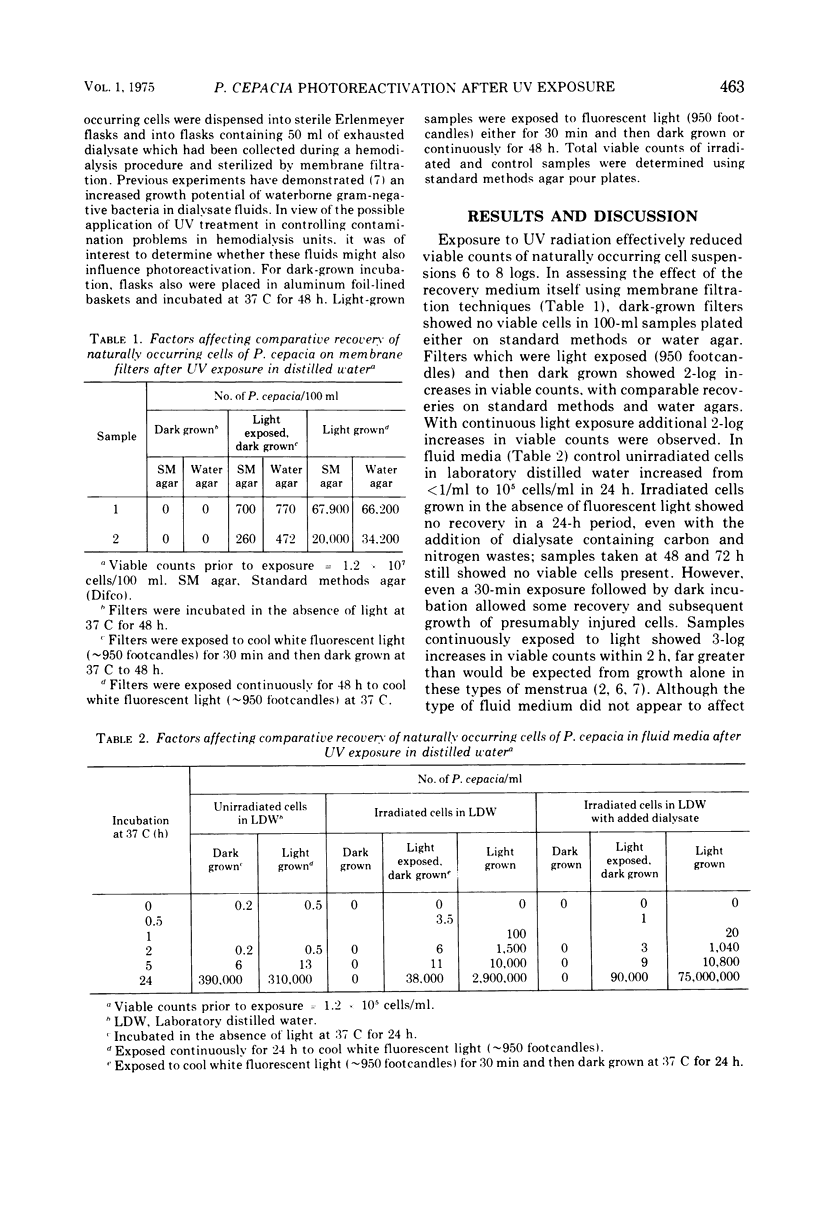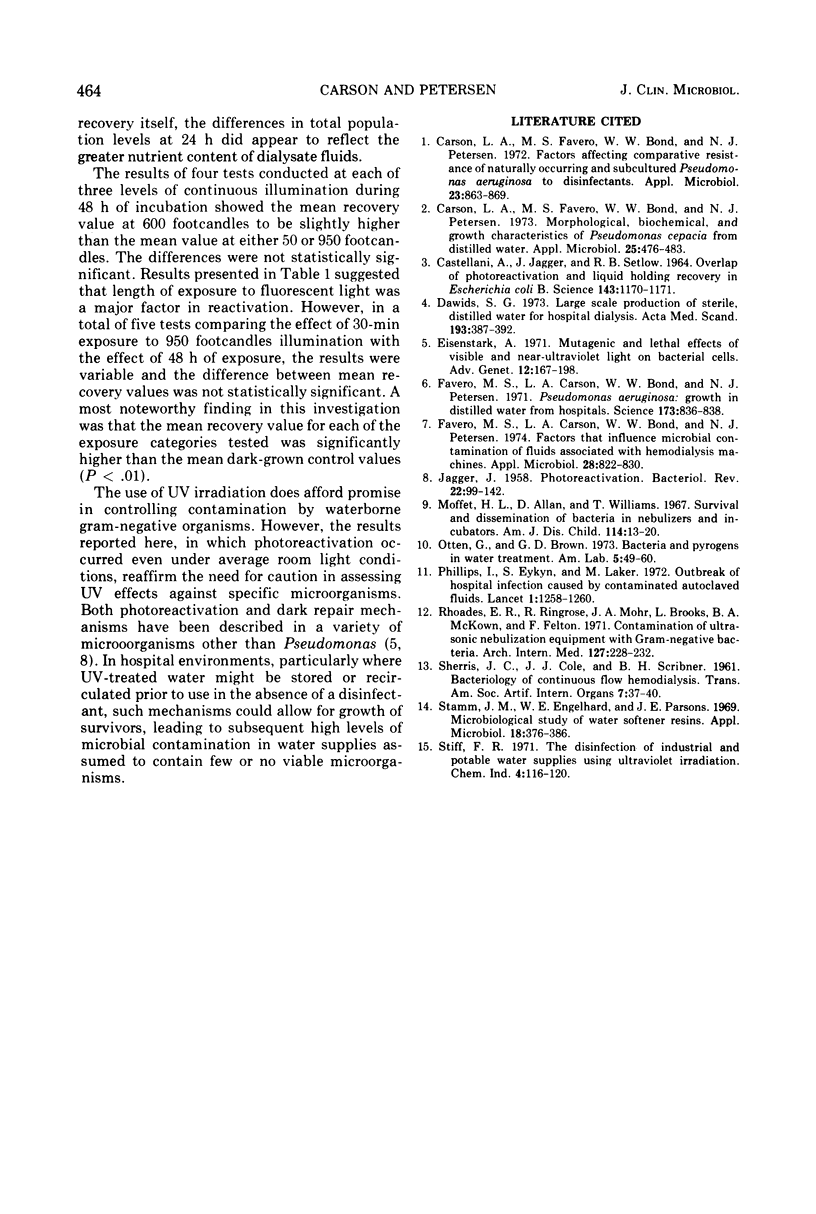Abstract
Cells of a naturally occurring strain of Pseudomonas cepacia grown in distilled water were exposed to ultraviolet radiation. Irradiated samples incubated on membrane filters or in fluid recovery media in the absence of light showed no evidence of dark repair mechanisms. When samples were exposed to fluorescent light ranging from 50 to 950 foot candles (538 to 10,222 lux) of illumination, apparent photo-induced repair of ultraviolet injury resulted in 1- to 4-log increases in viable cells recovered.
Full text
PDF


Selected References
These references are in PubMed. This may not be the complete list of references from this article.
- CASTELLANI A., JAGGER J., SETLOW R. B. OVERLAP OF PHOTOREACTIVATION AND LIQUID HOLDING RECOVERY IN ESCHERICHIA COLI B. Science. 1964 Mar 13;143(3611):1170–1171. doi: 10.1126/science.143.3611.1170. [DOI] [PubMed] [Google Scholar]
- Carson L. A., Favero M. S., Bond W. W., Petersen N. J. Factors affecting comparative resistance of naturally occurring and subcultured Pseudomonas aeruginosa to disinfectants. Appl Microbiol. 1972 May;23(5):863–869. doi: 10.1128/am.23.5.863-869.1972. [DOI] [PMC free article] [PubMed] [Google Scholar]
- Carson L. A., Favero M. S., Bond W. W., Petersen N. J. Morphological, biochemical, and growth characteristics of pseudomonas cepacia from distilled water. Appl Microbiol. 1973 Mar;25(3):476–483. doi: 10.1128/am.25.3.476-483.1973. [DOI] [PMC free article] [PubMed] [Google Scholar]
- Dawids S. G. Large scale production of sterile, distilled water for hospital dialysis. Description of equipment and evaluation of the water quality. Acta Med Scand. 1973 May;193(5):387–392. doi: 10.1111/j.0954-6820.1973.tb10598.x. [DOI] [PubMed] [Google Scholar]
- Eisenstark A. Mutagenic and lethal effects of visible and near-ultraviolet light on bacterial cells. Adv Genet. 1971;16:167–198. [PubMed] [Google Scholar]
- Favero M. S., Carson L. A., Bond W. W., Petersen N. J. Factors that influence microbial contamination of fluids associated with hemodialysis machines. Appl Microbiol. 1974 Nov;28(5):822–830. doi: 10.1128/am.28.5.822-830.1974. [DOI] [PMC free article] [PubMed] [Google Scholar]
- Favero M. S., Carson L. A., Bond W. W., Petersen N. J. Pseudomonas aeruginosa: growth in distilled water from hospitals. Science. 1971 Aug 27;173(3999):836–838. doi: 10.1126/science.173.3999.836. [DOI] [PubMed] [Google Scholar]
- JAGGER J. Photoreactivation. Bacteriol Rev. 1958 Jun;22(2):99–142. doi: 10.1128/br.22.2.99-142.1958. [DOI] [PMC free article] [PubMed] [Google Scholar]
- Moffet H. L., Allan D., Williams T. Survival and dissemination of bacteria in nebulizers and incubators. Am J Dis Child. 1967 Jul;114(1):13–20. doi: 10.1001/archpedi.1967.02090220019003. [DOI] [PubMed] [Google Scholar]
- Phillips I., Eykyn S., Laker M. Outbreak of hospital infection caused by contaminated autoclaved fluids. Lancet. 1972 Jun 10;1(7763):1258–1260. doi: 10.1016/s0140-6736(72)90981-6. [DOI] [PubMed] [Google Scholar]
- Rhoades E. R., Ringrose R., Mohr J. A., Brooks L., McKown B. A., Felton F. Contamination of ultrasonic nebulization equipment with gram negative bacteria. Arch Intern Med. 1971 Feb;127(2):228–232. [PubMed] [Google Scholar]
- Stamm J. M., Engelhard W. E., Parsons J. E. Microbiological study of water-softener resins. Appl Microbiol. 1969 Sep;18(3):376–386. doi: 10.1128/am.18.3.376-386.1969. [DOI] [PMC free article] [PubMed] [Google Scholar]
- Stiff F. R. The disinfection of industrial and potable water supplies using ultraviolet radiation. Chem Ind. 1971 Jan 23;4:116–120. [PubMed] [Google Scholar]


